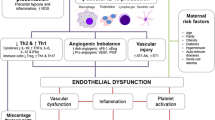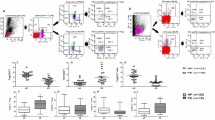Abstract
The etiology of preeclampsia (PE) is still unknown, and excessive immune activation is an important component of its pathogenesis. Programmed cell death protein 1 (PD-1) is one of immune checkpoints which may prevent overactivated immune attack and lead to a tolerant immune microenvironment. Little is known about the involvement of PD-1-mediated immunoregulation at the maternal–fetal interface in PE. To investigate the inflammatory pattern and the involvement of PD-1 in the decidua of women with PE, decidual tissues were obtained from PE and control pregnant women. Quantitative RT–PCR analysis of the mRNA levels of the inflammatory cytokines was performed. PD-1 expression was detected by immunohistochemistry, western blot analysis, and flow cytometry. To prove the role of PD-1, decidual immune cells were incubated with blocking antibodies, and the inflammatory cytokines were detected by ELISA. We observed that the mRNA levels of IL-1β, IL-6, TNF-α, and IFN-γ were higher in the decidua of the PE group than in the decidua of the control group. The mRNA levels of IL-4 and IL-10 were lower in PE. The expression level of PD-1 was significantly downregulated, and the proportion (%) of PD-1 + CD45 + cells was significantly lower in PE. There was a significant linear correlation between PD-1 expression and common proinflammatory cytokines in the decidua. Anti-PD-1 blocking antibody significantly increased the secretion of proinflammatory cytokines. Our data suggested that the inflammatory pattern and decreased PD-1 expression in the decidua might play an active role in the local immunoregulatory mechanisms of PE. The PD-1 pathway in the maternal–fetal interface possibly function to break the tolerant immune microenvironment in PE via inflammatory cytokines.






Similar content being viewed by others
References
Laresgoiti-Servitje E. A leading role for the immune system in the pathophysiology of preeclampsia. J Leukoc Biol. 2013;94(2):247–57.
ACOG Practice Bulletin No. 202: Gestational hypertension and preeclampsia. Obstet Gynecol. 2019;133(1):1. 0.1097/AOG.0000000000003018.
Rana S, Lemoine E, Granger JP, Karumanchi SA. Preeclampsia: pathophysiology, challenges, and perspectives. Circ Res. 2019;124(7):1094–112.
Rambaldi MP, Weiner E, Mecacci F, Bar J, Petraglia F. Immunomodulation and preeclampsia. Best Pract Res Clin Obstet Gynaecol. 2019;60:87–96.
Ander SE, Diamond MS, Coyne CB. Immune responses at the maternal-fetal interface. Sci Immunol. 2019;4(31):eaat6114.
Vishnyakova P, Poltavets A, Nikitina M, Muminova K, Potapova A, Vtorushina V, et al. Preeclampsia: inflammatory signature of decidual cells in early manifestation of disease. Placenta. 2021;104:277–83.
Sharpe AH, Pauken KE. The diverse functions of the PD1 inhibitory pathway. Nat Rev Immunol. 2018;18(3):153–67.
Mohamed Khosroshahi L, Parhizkar F, Kachalaki S, Aghebati-Maleki A, Aghebati-Maleki L. Immune checkpoints and reproductive immunology: pioneers in the future therapy of infertility related Disorders? Int Immunopharmacol. 2021;99:107935.
Jin LP, Fan DX, Li DJ. Regulation of costimulatory signal in maternal-fetal immune tolerance. Am J Reprod Immunol. 2011;66(2):76–83.
Dyck L, Mills KHG. Immune checkpoints and their inhibition in cancer and infectious diseases. Eur J Immunol. 2017;47(5):765–79.
Nguyen LT, Ohashi PS. Clinical blockade of PD1 and LAG3–potential mechanisms of action. Nat Rev Immunol. 2015;15(1):45–56.
Zych M, Roszczyk A, Kniotek M, Dąbrowski F, Zagożdżon R. Differences in immune checkpoints expression (TIM-3 and PD-1) on T cells in women with recurrent miscarriages-preliminary studies. J Clin Med. 2021;10(18):4182.
Mittelberger J, Seefried M, Franitza M, Garrido F, Ditsch N, Jeschke U, et al. The role of the immune checkpoint molecules PD-1/PD-L1 and TIM-3/Gal-9 in the pathogenesis of preeclampsia-a narrative review. Medicina (Kaunas). 2022;58(2):157.
Han X, Ghaemi MS, Ando K, Peterson LS, Ganio EA, Tsai AS, et al. Differential dynamics of the maternal immune system in healthy pregnancy and preeclampsia. Front Immunol. 2019;10:1305.
Yang F, Zheng Q, Jin L. Dynamic function and composition changes of immune cells during normal and pathological pregnancy at the maternal-fetal interface. Front Immunol. 2019;10:2317.
Arriaga-Pizano L, Jimenez-Zamudio L, Vadillo-Ortega F, Martinez-Flores A, Herrerias-Canedo T, Hernandez-Guerrero C. The predominant Th1 cytokine profile in maternal plasma of preeclamptic women is not reflected in the choriodecidual and fetal compartments. J Soc Gynecol Investig. 2005;12(5):335–42.
Hennessy A, Pilmore HL, Simmons LA, Painter DM. A deficiency of placental IL-10 in preeclampsia. J Immunol. 1999;163(6):3491–5.
Harmon AC, Cornelius DC, Amaral LM, Faulkner JL, Cunningham MW Jr, Wallace K, et al. The role of inflammation in the pathology of preeclampsia. Clin Sci (Lond). 2016;130(6):409–19.
Wilczyński JR, Tchórzewski H, Głowacka E, Banasik M, Szpakowski M, Wieczorek A, et al. ‘In vitro’ cytokine secretion by peripheral blood and decidual lymphocytes during the third trimester of normal pregnancy. Gynecol Obstet Invest. 2003;55(2):68–72.
Jung KY, Uprety LP, Jang YJ, Yang JI. Pro-inflammatory mediators and signaling proteins in the decidua of pre-eclampsia. Eur Rev Med Pharmacol Sci. 2020;24(23):12016–24.
Salha O, Sharma V, Dada T, Nugent D, Rutherford AJ, Tomlinson AJ, et al. The influence of donated gametes on the incidence of hypertensive disorders of pregnancy. Hum Reprod. 1999;14(9):2268–73.
Nakabayashi Y, Nakashima A, Yoshino O, Shima T, Shiozaki A, Adachi T, et al. Impairment of the accumulation of decidual T cells, NK cells, and monocytes, and the poor vascular remodeling of spiral arteries, were observed in oocyte donation cases, regardless of the presence or absence of preeclampsia. J Reprod Immunol. 2016;114:65–74.
Andrews LP, Yano H, Vignali DAA. Inhibitory receptors and ligands beyond PD-1, PD-L1 and CTLA-4: breakthroughs or backups. Nat Immunol. 2019;20(11):1425–34.
Meggyes M, Miko E, Szigeti B, Farkas N, Szereday L. The importance of the PD-1/PD-L1 pathway at the maternal-fetal interface. BMC Pregnancy Childbirth. 2019;19(1):74.
Meggyes M, Nagy DU, Szereday L. Investigation of the PD-1 and PD-L1 Immune checkpoint molecules throughout healthy human pregnancy and in nonpregnant women. J Clin Med. 2020;9(8):2536.
Gu Y, Morgan J, Lewis DF, Cooper DB, McCathran CE, Wang Y. Maternal soluble PD-1 levels are significantly increased in women with preeclampsia. Am J Reprod Immunol. 2020;83(1):e13193.
Blackburn SD, Shin H, Haining WN, Zou T, Workman CJ, Polley A, et al. Coregulation of CD8+ T cell exhaustion by multiple inhibitory receptors during chronic viral infection. Nat Immunol. 2009;10(1):29–37.
Darmochwal-Kolarz D, Saito S, Rolinski J, Tabarkiewicz J, Kolarz B, Leszczynska-Gorzelak B, et al. Activated T lymphocytes in pre-eclampsia. Am J Reprod Immunol. 2007;58(1):39–45.
Barber DL, Wherry EJ, Masopust D, Zhu B, Allison JP, Sharpe AH, et al. Restoring function in exhausted CD8 T cells during chronic viral infection. Nature. 2006;439(7077):682–7.
Qiu MK, Wang SC, Dai YX, Wang SQ, Ou JM, Quan ZW. PD-1 and Tim-3 pathways regulate CD8+ T cells function in atherosclerosis. PLoS ONE. 2015;10(6):e0128523.
Zhao Y, Zhang X, Du N, Sun H, Chen L, Bao H, et al. Immune checkpoint molecules on T cell subsets of pregnancies with preeclampsia and gestational diabetes mellitus. J Reprod Immunol. 2020;142: 103208.
Wang X, Yang X, Zhang C, Wang Y, Cheng T, Duan L, et al. Tumor cell-intrinsic PD-1 receptor is a tumor suppressor and mediates resistance to PD-1 blockade therapy. Proc Natl Acad Sci U S A. 2020;117(12):6640–50.
Xu YY, Wang SC, Li DJ, Du MR. Co-signaling molecules in maternal-fetal immunity. Trends Mol Med. 2017;23(1):46–58.
Acknowledgements
The authors would like to thank all patients for their voluntary participation in this study and physicians at all study sites for their contribution.
Funding
This work was supported by the National Natural Science Foundation of China (81741038), the Jinan Science and Technology Program (201805025) and the Program from the Key Laboratory of Birth Regulation and Control Technology of National Health and Family Planning Commission of China (2021002).
Author information
Authors and Affiliations
Corresponding author
Ethics declarations
Ethics Approval
This experiment was reviewed and approved by the Ethics Committee of Shandong Provincial Hospital.
Consent to Participate
All patients and their families voluntarily participated in this experiment and signed an informed consent form.
Consent for Publication
In the consent form, patients were informed that their data will be shared in summarized form grouped with other patients in published papers.
Conflict of Interest
The authors declare no competing interests.
Rights and permissions
About this article
Cite this article
Wang, S., Liu, Y., Liang, Y. et al. Excessive Immune Activation and the Correlation with Decreased Expression of PD-1 at the Maternal–Fetal Interface in Preeclampsia. Reprod. Sci. 30, 192–202 (2023). https://doi.org/10.1007/s43032-022-01003-z
Received:
Accepted:
Published:
Issue Date:
DOI: https://doi.org/10.1007/s43032-022-01003-z




